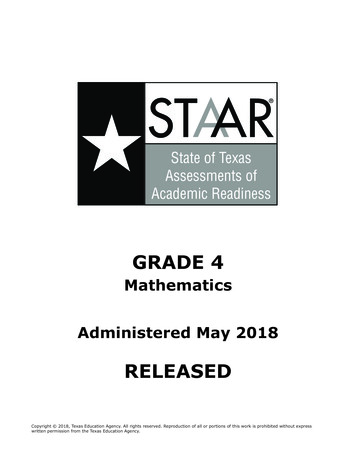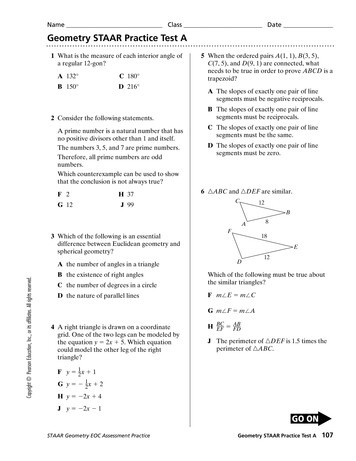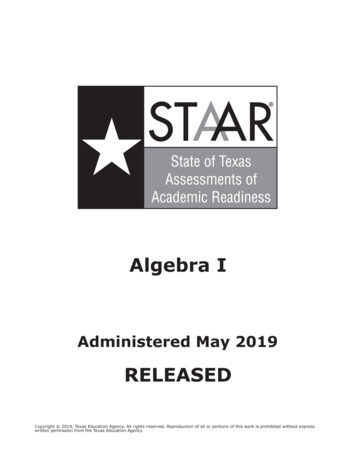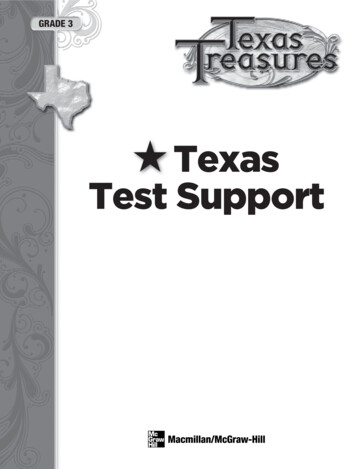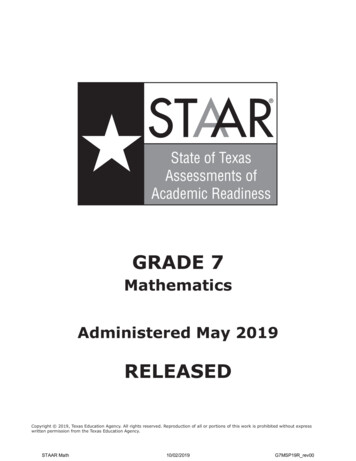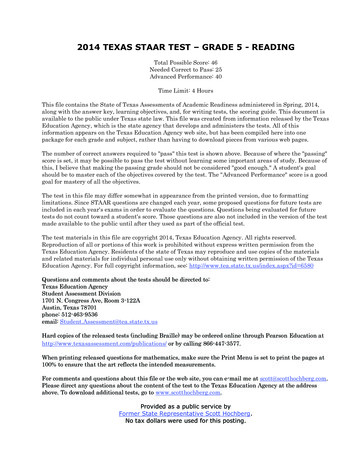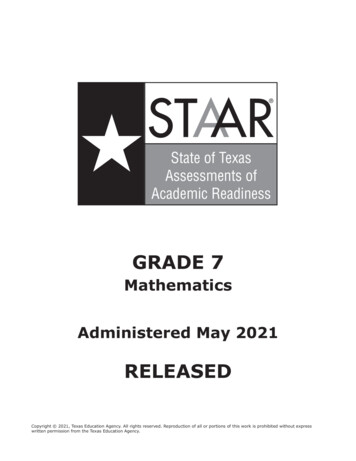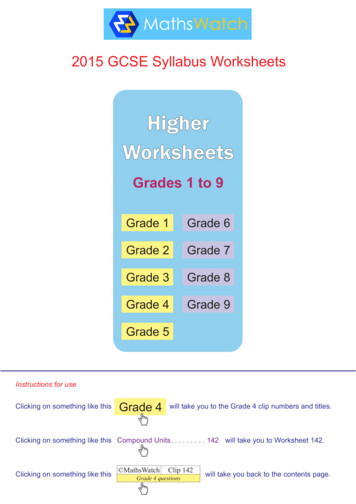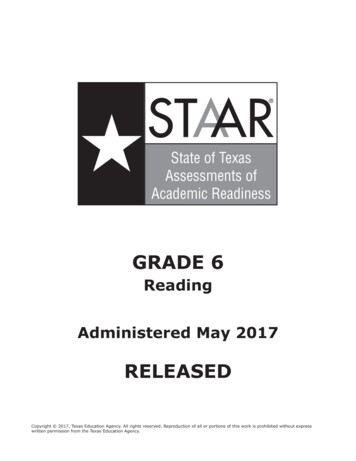
Transcription
STAAR State of TexasAssessments ofAcademic ReadinessGRADE 6ReadingAdministered May 2017RELEASEDCopyright 2017, Texas Education Agency. All rights reserved. Reproduction of all or portions of this work is prohibited without expresswritten permission from the Texas Education Agency.
READINGReadingPage 1
Read the selection and choose the best answer to each question. Then fill inthe answer on your answer document.In the Blink of an Eye1Have you ever played the blinking game with friends? It’s fun to see who canlast the longest without blinking. After 30 seconds you probably struggle toresist closing and then reopening your eyes. In fact, most people blink everythree to seven seconds. However, you rarely think about it. Blinking usuallyoccurs automatically, like your heartbeat.Miniature Windshield Wipers2What happens when you blink? Each time you blink, muscles around your eyescontract to close your eyelids. Then two different muscles contract, raising youreyelids back up.Diagram of an EyeLevator muscleof the eyelidEyelidMuscles that controleye movementReadingPage 2Eyeball
3Your eyelids act like tiny windshield wipers. In the blink of an eye, they sweepdust and debris away. Eyelids also spread moisture. Glands in the eyelidslubricate the surface of the eyes. Without this repeated lubrication, youreyeballs begin to dry, and your eyelids feel sticky.Quick as a Blink4People can blink on purpose. However, most blinking occurs involuntarily. Yourarely notice this type of blink, which is incredibly fast. Your brain actuallyignores the flash of darkness caused by a blink, giving you the impression ofuninterrupted sight.5Each time you blink, your eye closes for about three-tenths of a second. Witharound 15,000 blinks per day, you can end up with your eyes shut from blinkingfor up to one hour and fifteen minutes a day! Yet you probably aren’t aware thatyour vision is interrupted for that amount of time each day.Think Before You Blink6According to scientific research, the average eye blink rate in people variesgreatly, ranging from 2 to 50 blinks a minute. Many factors affect the blink rate.7One factor is age. Newborn babies rarely blink. The reasons for this aren’tentirely clear, but one theory is that babies work hard to observe the worldaround them because their ability to see is not fully developed. Blink ratesincrease in childhood. From there, rates increase steadily until adulthood. Thenblink rates decrease as people move into older adulthood. That’s when themuscles that control eyelids eventually lose some of their tone and ability tomove.8Your blink rate also varies with the task being performed. You’ll blink less whenyou’re concentrating on something. For example, have you ever noticed thatwhen you search the Internet on your computer, your eyes sting, burn, or feelscratchy? Your eyes dry out because your blink rate decreases by half while youare concentrating on looking at something. If you’re absorbed in reading, yourblink rate will decrease. And you’ll blink less if you’re watching a scary movie,since the threat of danger causes people to be more observant.9When you’re thinking but not actually looking at something, your blink rate willalso decrease. In school, when your teacher asks you a question, you’ll barelyblink as you consider the answer. Once you start to reply, your blink rate willincrease. Talking returns you to a standard blink rate. What happens if you thinkaloud while pondering the answer to a question? Your blink rate will return to itsstandard rate since you’re speaking.10ReadingPage 3Some activities, such as telling a lie, require a great deal of concentration. Aspeople think about their lie, their blink rate is very low. Police use thisknowledge to gain information from suspects when interrogating them. So thenext time you think about telling a fib, you might keep in mind that yourblinking eyes always tell the truth.
1 Why aren’t people bothered by the interruptions to vision caused by blinking?AThe brain is designed to ignore very brief moments of darkness.BBlinking relaxes people’s eyes.CBlinking removes dust that lands on the eyes.D The brain can process information even when people’s eyes are closed.2 The section “Think Before You Blink” is organized in a way that shows —Fhow blinking is affected by the use of different electronic devicesG the various factors associated with blinking ratesH the different benefits babies and adults get from blinkingJwhich parts of the eye are responsible for blinking3 Based on the labels in the diagram of the human eye, the reader can conclude that —Amore muscles are used to move the eye than to blinkBeye muscles are stronger than any other muscles in the bodyCblinking provides several benefits to the eyeballD blinking happens in a way that does not affect a person’s visionReadingPage 4
4 Read this sentence from paragraph 1.Blinking usually occurs automatically, like your heartbeat.Which statement from the article supports the idea in this sentence?FThat’s when the muscles that control eyelids eventually lose some of their tone and abilityto move.G You rarely notice this type of blink, which is incredibly fast.H Without this repeated lubrication, your eyeballs begin to dry, and your eyelids feel sticky.JEach time you blink, your eye closes for about three-tenths of a second.5 Which sentence from the article helps explain why staring at a computer screen affects blinkrates?AThen blink rates decrease as people move into older adulthood.BAfter 30 seconds you probably struggle to resist closing and then reopening your eyes.CYou’ll blink less when you’re concentrating on something.D When you’re thinking but not actually looking at something, your blink rate will alsodecrease.ReadingPage 5
Read the selection and choose the best answer to each question. Then fill inthe answer on your answer document.For Deanna’s Eyes Only!CharactersJONATHAN, 11 years oldDEANNA, 14 years oldSCENE 11[A teenage girl’s bedroom. Jonathan sits on the bed reading a diary. He shakeshis head, turns a page, continues reading. Deanna enters and stops short. Shestares in disbelief as Jonathan goes on reading, totally oblivious to herpresence.]2DEANNA: [Indignantly.] What do you think you’re doing?3JONATHAN: [Startled.] Ah! [Slams the diary shut.]4DEANNA: What are you doing?5JONATHAN: Nothing!6DEANNA: You’re reading my diary!7JONATHAN: [As if he’s confused.] Diary?8DEANNA: [Pointing.] That! Right there! In your hands!9[Jonathan looks down at his hands and reacts as if he is shocked to seesomething in them.]10DEANNA: Oh, cut it out. You know what you were doing.11JONATHAN: I wasn’t reading it.12DEANNA: I stood here and watched you. I’ve told you a million times to stayaway from my things. Why are you even in my room?13JONATHAN: Doing you a favor.14DEANNA: Snooping through my private things? That’s your idea of a favor?15JONATHAN: I wasn’t snooping. I was cleaning up after you. Mom told me tostraighten up the family room, and most of the mess was yours. If this diary isso private, why’d you leave it on the couch?16DEANNA: So to put my stuff away, you had to read my diary?ReadingPage 6
17JONATHAN: No. I didn’t even want to read it. But you gave me the impressionthat you wanted me to, so . . .18DEANNA: [In total disbelief.] What? I gave you the impression that I—are youcrazy?19JONATHAN: Well, I figured from what you wrote on the cover . . .20DEANNA: I didn’t write “For everybody’s eyes—especially Jonathan’s!” I wrote“FOR DEANNA’S EYES ONLY!” That somehow gave you the impression that Iwanted you to read it?21JONATHAN: Well, if you write something like that on the cover and then leaveit lying around, what do you expect?22DEANNA: I expect people to mind their own business.23JONATHAN: Oh, that’s like putting a plate of brownies out on a table and thengetting mad when someone eats one. If you really wanted to keep your writingsecret, you’d bury it in the middle of some half-used-up notebook where nobodybut you would even think to look.24DEANNA: So it’s my fault you violated my privacy?25JONATHAN: It was kind of like false advertising.26DEANNA: False advertising?27JONATHAN: Sure. When you use phrases like “DO NOT OPEN—OR ELSE!” thereader is going to expect something riveting. Not complaints about the schoolcafeteria.28DEANNA: What?29JONATHAN: I’m just saying that with a title like that, the reader’s going toexpect some drama—or at the very least, an embarrassing story.30[From offstage Deanna’s mother calls her to leave for volleyball practice.]31DEANNA: [To Jonathan.] This isn’t over! [Deanna exits, taking the diary withher. Jonathan shrugs and exits after her.]SCENE 232[Family room. Jonathan is watching TV. Deanna enters with the diary and sitson the couch opposite Jonathan.]33DEANNA: O.K., let me hear it.34JONATHAN: Hear what?35DEANNA: [Amazed.] The apology you owe me for reading my diary!ReadingPage 7
36JONATHAN: Oh that. I was kind of a sneak to read it behind your back.37DEANNA: Yeah, you were.38JONATHAN: You want to know the real reason I started reading it?39DEANNA: O.K., why did you?40JONATHAN: Well, lately, it’s like I’ve been invisible to you.41DEANNA: What are you talking about? We do stuff all the time.42JONATHAN: We used to do stuff all the time. Have you even read your owndiary?43DEANNA: Well, no. I’ve just been writing in it.44JONATHAN: About your friends. And school. And Jeremy.45DEANNA: And?46JONATHAN: And that’s it. I’m not in it anywhere. Take a look. You won’t evenfind my name.47DEANNA: [Looks down at the diary in her hands.] I guess I have been busy.But that still doesn’t give you the right to read my private diary.48JONATHAN: I know. And I am sorry, but I just had to find out if you were madat me.49DEANNA: [Sighs.] I’m not mad at you; I’ve just been preoccupied. I’ve beenso busy with my first year of high school, trying to keep up and fit in. [Pausesfor a moment.] But if you promise not to read my diary anymore, I promise todo something with you at least once a week from now on.50JONATHAN: O.K., sounds good to me. [Pauses.] But you may want to keepyour diary in your room, just in case. [Both exit the stage.]ReadingPage 8
6 Read the dictionary entry for the word violate.ıviolate \ vī-ə-ılāt\ v1. to break a rule 2. to interfere withsomeone’s rights 3. to abuse somethingby causing damage 4. to interrupt acontinuous state or actionWhich definition most closely matches the way the word violated is used in paragraph 24?FDefinition 1G Definition 2H Definition 3JDefinition 47 What does Jonathan’s dialogue in Scene 1 suggest about him?AHe feels bad about reading the diary.BHe misses spending time with Deanna.CHe is deeply interested in Deanna’s life.D He believes he didn’t really do any harm.ReadingPage 9
8 What is the best summary of Scene 1?FAfter Deanna finds Jonathan reading her diary, the two have a conversation about hisactions. Deanna feels as though Jonathan is always going through her private thingswithout asking.G Deanna catches Jonathan in her room reading her diary and demands to know what he isdoing. Jonathan at first denies reading it but then claims it seems like Deanna wanted himto read it.H Jonathan is cleaning up the family room and begins reading Deanna’s diary because ofwhat she wrote on the cover. He is disappointed to find that her diary does not containany embarrassing stories.JDeanna and Jonathan disagree over the meaning of the words she wrote on the cover ofher diary. She thinks he should not have read it, and he thinks she is guilty of falseadvertising.9 Which statement expresses a main theme of the play?AWriting can be a helpful way to deal with stress.BKeeping secrets can lead to problems in a relationship.CIt is best to apologize when something wrong has been done.D People must make time for one another in order for relationships to thrive.ReadingPage 10
10 From Scene 1 to Scene 2, the dialogue between Deanna and Jonathan becomes more —Fdemanding and judgmentalG confused and suspiciousH honest and seriousJtense and angry11 How is the play’s conflict resolved?AJonathan says he is sorry for what he did.BDeanna explains that she has too many commitments.CDeanna promises to spend more time with Jonathan.D Jonathan suggests that Deanna keep her diary in her room.ReadingPage 11
Read the next two selections. Then choose the best answer to eachquestion.Prince Patrick1“No,” Tiffany said. “When you sip from your cup, you have to stick yourlittle finger out like this.” She pointed her pinkie into the air.2“Let’s play something else,” Patrick begged, rubbing his leg that wasjammed underneath a tiny table.3Drinking imaginary tea from a plastic teacup with his sister Tiffany andcousin Annabel was not Patrick’s idea of fun.4“Let’s play save the princesses,” the girls shouted.5Patrick sighed. “This is not how I imagined I would be spending Saturdayafternoon,” he thought. Usually his mother watched Annabel when AuntElizabeth worked—but not today.6Patrick had been in the middle of a great dream when his mother shookhim awake that morning. “I had to work overnight,” Mom whispered, “and Ineed to get some sleep. Will you please watch your cousin and sister for me?Annabel will be here any minute.”7“Sure, no problem,” Patrick told his mother. “This should be simple,” hethought.8“What was I thinking?” Patrick muttered as the girls dumped out a bagfilled with brushes, barrettes, and ribbons. Patrick had expected to turn on amovie to keep them occupied. That would make babysitting easy. But the girlswere more interested in tormenting him than watching a movie.9“Now braid our hair so we look like beautiful princesses,” Tiffanydemanded.10Patrick didn’t even know how to braid hair. He attempted to work with thegirls’ locks of hair but found the hair to be as slippery as a handful of wetnoodles. Finally, with the help of an online video, he managed to entwine theirhair into braids that looked fairly neat and even. Patrick actually felt impressedwith his handiwork.11The girls chatted about Patrick’s work as they positioned shimmeringcrowns on their heads. Patrick hid a smile.12Holding out sparkly wands, the girls dashed behind a chair, calling to him,“Save us, Prince Patrick!”13Tiffany and Annabel’s eyes twinkled. Patrick paused. “Might as well makethis fun,” he thought.ReadingPage 12
141516ReadingPage 13Patrick gathered some items from the kitchen. He threw his mother’s apronover his shoulders, straddled a broom, and raised a spatula in the air. “PrincePatrick to the rescue!” he cried as he galloped across the living room. “Takethat, you evil dragon!” Patrick called out, whacking an imaginary dragon with hisspatula and throwing open a pretend gate. “Stay away from my princesses!”“You saved us! Thank you! You’re our hero!” the girls cheered.Patrick’s mother stood at the doorway like a fly on the wall, surveying thescene. “Mine, too!” she added. “Thank you, Prince Patrick!”
A Wintry Welcome1When we moved to Minnesota, I was intent on transplanting Charlie intothe garden of our new house. Charlie was the cactus I dug up from our yard inTexas right before we moved. I wanted something to remind me of the home Ireluctantly had to leave.2I yanked open the front door with Charlie cradled in my arm. An expresstrain of polar air blasted me in the face as I stepped onto the porch. Thetemperatures had been frigid the past few days, but overnight the landscapehad been transformed into a world of white that blanketed every surface. Thewind crammed icy fingers down the back of my neck. “How do people live insuch a harsh environment?” I wondered, recalling the warm Texas sun.3Planting Charlie outside clearly wasn’t going to happen anytime soon.4As I stood there, two kids on the sidewalk waved to me. The boy shouted,“Are you our new neighbor?”5“Of course she is,” the girl said. “I’m Kristin, and this is my brother Kyle.”6“I’m Emily,” I said.7“Do you want to go ice-skating with us?” Kristin asked. She pointed to thefrozen pond across the street from my house. “We have a few extra pairs ofskates at our house.”8Within the hour I was sitting with Kristin and Kyle on the bench next to thepond. The untouched snow bordering the pond glittered in the sun as if a milliondiamonds were sprinkled across its surface. I studied the ice skates. I knew howto roller-skate, but these skates looked very different.9Kristin laced my skates for me. When I inhaled, icy air filled my lungs. Kylewrapped his knit scarf around my neck, pulling it up over my mouth and nose.“You’ll get used to the cold,” he said, grinning.10Kyle helped me stand up. “Not too bad,” I thought.11But then I attempted to take a step, and my feet flew out from underneathme. I landed on the solid ice with a thud.12Kyle and Kristin hauled me up and supported me on each side as I slippedand stumbled. After a while I was able to balance on my own. I figured out howto push off and glide too. By the end of the day, I was able to make tiny,tentative turns on the ice. I almost forgot about Texas as I concentrated on mynew friends instead.ReadingPage 14
13ReadingPage 15Light shone through the open curtains of the front window of my houseacross the street, and I could see Charlie on the table inside. “We transplantswill be all right here,” I thought with a wide grin from beneath the knit scarf.
Use “Prince Patrick” (pp. 12–13) to answer questions 12–15. Then fill inthe answers on your answer document.12 Based on paragraphs 7 and 8 of the story, what can the reader infer about Patrick?FHe thinks he can entertain the girls by styling their hair.G He believes he is a good babysitter.H He does not get along with his sister and cousin.JHe would prefer to do as little work as possible.13 Patrick’s feelings about babysitting begin to become more positive when he —Aplans to entertain the girls with a movieBsits at a tiny tableCbraids the girls’ hairD hits an imaginary dragon with a spatulaReadingPage 16
14 What is the best summary of paragraphs 12 through 16?FPatrick chooses to play a game with the girls he is babysitting. He pretends to battle animaginary dragon while the girls act like princesses. He pretends to open a gate and thentells the imaginary dragon to stay away from the princesses. Patrick’s mother watches thechildren as they play.G Patrick decides to use his imagination and play with the girls to make them happy. Hepretends to fight an imaginary dragon to rescue the girls, who are acting like princesses introuble. The girls thank him for rescuing them. Patrick’s mother watches and thanks himfor helping her, too.H Patrick uses an apron, a broom, and a spatula in order to play a game. He pretends tobattle an imaginary dragon while the girls act like princesses. The girls are grateful forPatrick rescuing them from an imaginary dragon. Patrick’s mother hears the girls thankPatrick.JPatrick imagines he is a prince fighting with a dragon as he gallops across the room. Thegirls hide behind a chair while he swings at the imaginary dragon with his spatula andpretends to defeat it. The girls, who are pretending to be princesses, thank him. They sayhe is their hero for rescuing them.15 Read this sentence from paragraph 10.He attempted to work with the girls’ locks of hairbut found the hair to be as slippery as a handfulof wet noodles.The author uses the simile in this sentence to show that Patrick —Athinks the girls have gotten food in their hairBthinks that the girls’ hair is too wet to make proper braidsCwould prefer to be cooking dinner rather than braiding hairD finds it very difficult to make braids in the girls’ hairReadingPage 17
Use “A Wintry Welcome” (pp. 14–15) to answer questions 16–19. Then fillin the answers on your answer document.16 How can the reader tell that Emily enjoyed living in Texas?FShe goes ice-skating with two of her new neighbors.G She brought a cactus with her to plant at her new home.H She learned to roller-skate before moving to her new home.JShe notices that the weather is different between the two states.17 The word tentative comes from the Latin word tentare, which means “to feel or try.” Whatdoes tentative mean in paragraph 12?ACautiousBExcitingCMultipleD EnjoyableReadingPage 18
18 What is hidden from the reader as a result of the story being told from the first-person pointof view?FEmily’s reason for bringing Charlie with her from TexasG The actions of Emily with Kyle and KristinH Kyle and Kristin’s thoughts about EmilyJThe dialogue between Kyle and Kristin19 Read this sentence from paragraph 8.The untouched snow bordering the pond glitteredin the sun as if a million diamonds were sprinkledacross its surface.What does the author’s use of imagery in this sentence emphasize?AEmily believes that the icy pond will be hard if she falls.BEmily realizes the value of learning how to ice-skate.CEmily thinks the snow is beautiful.D Emily thinks the snow is too bright.ReadingPage 19
Use “Prince Patrick” and “A Wintry Welcome” to answer questions 20–23.Then fill in the answers on your answer document.20 What is one similarity in the way the main characters work through their conflicts?FBoth main characters adopt a new attitude that leads to a resolution.G Both main characters make a mistake that adds to their problems.H Both main characters perform a task that leads to recognition from others.JBoth main characters resolve their concerns by focusing on the needs of others.21 Read these sentences from both stories.“Prince Patrick”“What was I thinking?” Patrick mutteredas the girls dumped out a bag filledwith brushes, barrettes, and ribbons.(paragraph 8)“A Wintry Welcome”Planting Charlie outside clearly wasn’tgoing to happen anytime soon.(paragraph 3)What do these sentences show about the main character of each story?AThey both rely on friends for support.BThey both are used to taking care of others.CThey both have accepted a big responsibility.D They both realize their situation is not going as planned.ReadingPage 20
22 In what way do both Patrick from “Prince Patrick” and Emily from “A Wintry Welcome” changethroughout the stories?FThey both are worried but then become relieved in the end.G They both feel doubtful about their abilities but then become confident.H They both are unhappy about their circumstances but then learn to accept them.JThey both feel excited at first but then are displeased with events that occur.23 Read this sentence from “A Wintry Welcome.”I almost forgot about Texas as I concentrated onmy new friends instead.Which sentence from “Prince Patrick” shows that Patrick begins to feel the same way?A“This is not how I imagined I would be spending Saturday afternoon,” he thought.BPatrick didn’t even know how to braid hair.CThe girls chatted about Patrick’s work as they positioned shimmering crowns on theirheads.D “Might as well make this fun,” he thought.ReadingPage 21
Read the selection and choose the best answer to each question. Then fill inthe answer on your answer document.HARP and Its Angels1At the southeast end of Brooklyn, New York, lie the ruins of a once-great airfield.Floyd Bennett Field was New York City’s first municipal airport. It opened in1931, when propeller planes were commonplace. Many well-known pilots usedthis airport, including Amelia Earhart, who took off and landed at the airfieldseveral times.2When the United States entered World War II in 1941, Floyd Bennett Field wasthe most active airport in the country. By then it had become a military airstation. Some of the soldiers stationed there flew missions watching for enemysubmarines. Others trained as pilots. Still others flew planes across the countryto the West Coast to prepare for battles in the Pacific region.3Activity declined at the airport in the years following World War II, and FloydBennett Field was closed in the early 1970s. The airfield and its hangars, largegarages that had once stored airplanes, fell into disrepair. On the outside of thebuildings, sheets of partially peeled aluminum flapped in the wind. Weeds grewin cracks in the runways.4World War II veteran Arnie Migliaccio imagined a better fate for the historicairfield. He thought the area could be used to preserve and display old planes.In 1996, Migliaccio presented his idea to the National Park Service, an agencythat works to preserve historic sites. Because of his suggestion, HARP—theHistoric Aircraft Restoration Project—was born.5The project brought new life to the airfield. What had become a neglectedremnant of history transformed into a place where people could learn about andexplore planes from the past. To accomplish this, the National Park Servicefocused on three goals for the project. First, its volunteers conducted research inorder to reproduce full-scale models of historic airplanes to the higheststandard. Second, volunteers performed restoration work to return aircraft tonear-perfect condition in appearance, although the planes will not fly again.Finally, the project assured that the aircraft will be maintained in good conditionso that future generations can learn about aviation history. HARP continues tostrive to meet these goals today.6At the heart of HARP are its “angels,” the volunteers who have given thousandsof hours every year to work on the aircraft. Some are retired pilots andengineers. Many of the angels served during wartime on aircraft like the onesrestored by HARP.7For example, Robert Weiss was a navy reservist during the Cold War era in the1950s. He flew on a P2V Neptune, patrolling the Atlantic coast for enemysubmarines. Now he returns weekly to Hangar B, where the restored planes arekept. “I love it,” he says. “It brings back memories and keeps us young.”ReadingPage 22
The jewel of the fleet in Hangar B is a PBY Catalina plane. During World War II,seaplanes like the Catalina would roll down the ramp behind the hangar and intoNew York Harbor. These seaplanes, which could float as well as fly, had theimportant role of defending ships leaving the harbor. After taking off from thewater, the planes would escort the ships from above to safeguard them fromenemy submarines below.A PBY Catalina Plane on Display in Hangar B9ReadingPage 23Courtesy of NPS8The HARP program has been responsible for restoring nine historic aircraft. Thepublic is able to view the impressive collection of planes in Hangar B three daysa week. At least 1,000 students visit every week. Visitors can see, hear, and feelwhat it is like to be in a functioning airplane hangar. Visitors and volunteersshare moments in aviation history. It is like traveling back in time.
24 How did the idea for HARP come about?FA veteran thought of a practical use for a historic airfield.G The National Park Service wanted to open an airfield to the public.H Citizens of New York City wanted to honor their airfield’s military past.JPilots who flew during World War II needed a place to restore old planes.25 What is the most likely reason the National Park Service chose the three goals mentioned inparagraph 5 for the project?AIt wanted the work of HARP to create accurate portrayals of history that would last.BIt wanted to provide opportunities for HARP volunteers to learn aircraft maintenance skills.CIt wanted to be sure the planes restored by HARP would not be flown for other purposes.D It wanted HARP researchers to discover information that could be useful for future aircraft.ReadingPage 24
26 Read the dictionary entry.ıjewel \ jü-əl\ n1. a decorative piece of metal wornas an accessory 2. a valuable gem3. a person or object that is highlyvalued 4. a part of a watch that ismade of crystal or glassWhich definition best matches the meaning of jewel as it is used in paragraph 8?FDefinition 1G Definition 2H Definition 3JDefinition 427 Read this sentence from paragraph 1.At the southeast end of Brooklyn, New York, liethe ruins of a once-great airfield.Which fact from the selection best supports this claim?AWhen the United States entered World War II in 1941, Floyd Bennett Field was the mostactive airport in the country.BIt opened in 1931, when propeller planes were commonplace.CFloyd Bennett Field was New York City’s first municipal airport.D Still others flew planes across the country to the West Coast to prepare for battles in thePacific region.ReadingPage 25
28 What does the word remnant mean in paragraph 5?FStoryG LeftoverH MachineJDiscovery29 What is the best summary of the selection?AFloyd Bennett Field was an airfield from which notable pilots and military aircraft flewimportant missions. The airfield was closed in the early 1970s, but in 1996, ArnieMigliaccio proposed an idea to the National Park Service to make the neglected airfield aplace to display restored aircraft. The project became known as HARP, and volunteersknown as “angels” work to help meet the project’s goals. Today visitors to Hangar B learnabout the history of the airfield and planes.BHARP was founded in order to restore aircraft and an old airfield where the rebuilt aircraftcould be displayed. The aircraft were restored by volunteers, many of whom were retiredmilitary pilots or aircraft engineers. They spent thousands of hours making planes such asthe PBY Catalina like new. Students go each week to view the aircraft and learn about thehistory of aviation from the volunteers of HARP.CIn 1996 a veteran named Arnie Migliaccio proposed an idea to the National Park Service tomake Floyd Bennett Field a place to view restored airplanes. The HARP volunteers beganworking to repurpose the site and several aircraft from the World War II era. Today therestored planes no longer fly, but the HARP volunteers work to ensure that the planes willremain in good condition for many years.D Floyd Bennett Field was opened in 1931 and became a busy airport over the years.Famous pilots used the airfield, and military planes used it during times of war to flyimportant missions. After it was closed in the early 1970s, the airfield became run-down.But in 1996, veteran Arn
A teenage girl's bedroom. Jonathan sits on the bed reading a diary. He shakes his head, turns a page, continues reading. Deanna enters and stops short. She stares in disbelief as Jonathan goes on reading, totally oblivious to her presence.] 2 . DEANNA: [Indignantly.] What do you think you're doing? 3 . JONATHAN: [Startled.] Ah! [Slams the .
